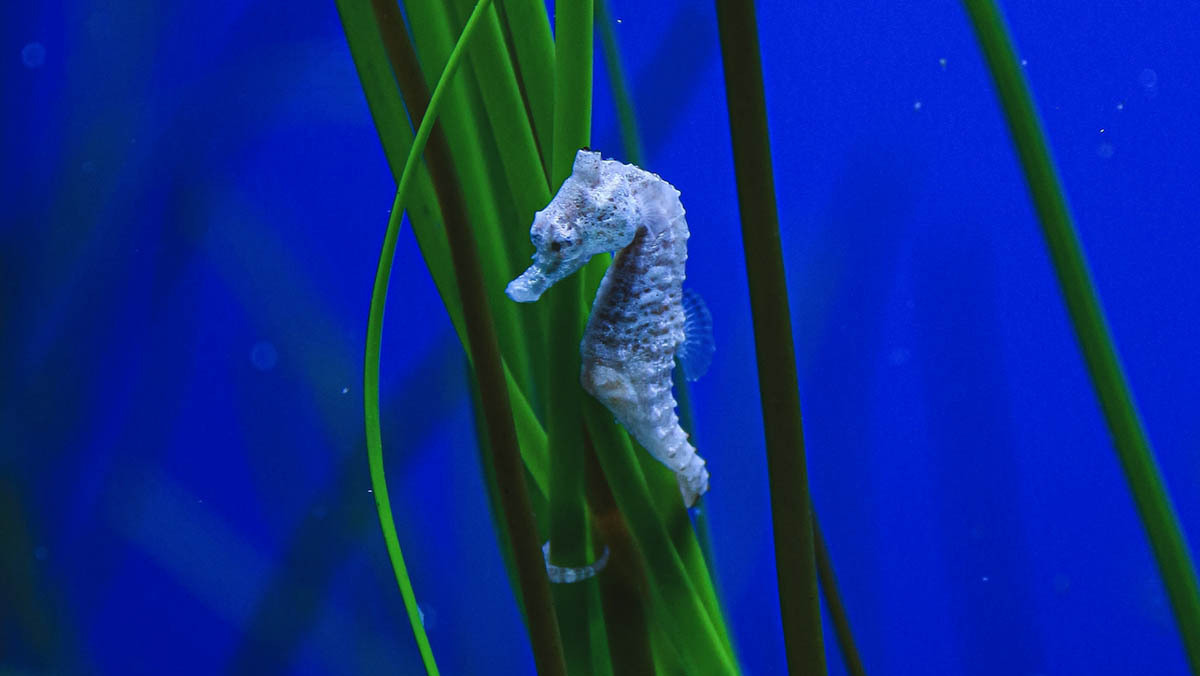
Did you know that seagrass meadows are thirty-five times more effective at carbon capture than the typical tropical rainforest? Seagrass meadows account for only 0.1 per cent of the sea’s bed, but an estimated 10 per cent of its carbon capture. They are great for biodiversity, too. Scientists have found that they provide a habitat that sustains up to 40 per cent more sea-life; around the UK’s shorelines that means species as diverse as rare seahorses and commercially important fish like juvenile cod, flounder and mullet. Seagrass meadows also increase shoreline stability by absorbing the impact of storms and thus help to protect coastal settlements from erosion by the sea.
That’s great news for the UK, along whose 12,249km shoreline two varieties of Zosteraceae family of seagrasses grow: one (Zostera marina) underwater in the littoral zone close to the shore, and the other (Zostera noltii) inter-tidally. It is particularly good news for the South West, which is home to just over 25 per cent of the UK’s estimated 8,500 hectares of seagrass meadow. The other large concentrations are within the Scottish Highlands and Islands (24.21 per cent), off Northern Ireland (14.44 per cent), around the Isle of Wight (8.41 per cent) and in the Lindisfarne area off Northumbria (8.01 per cent).
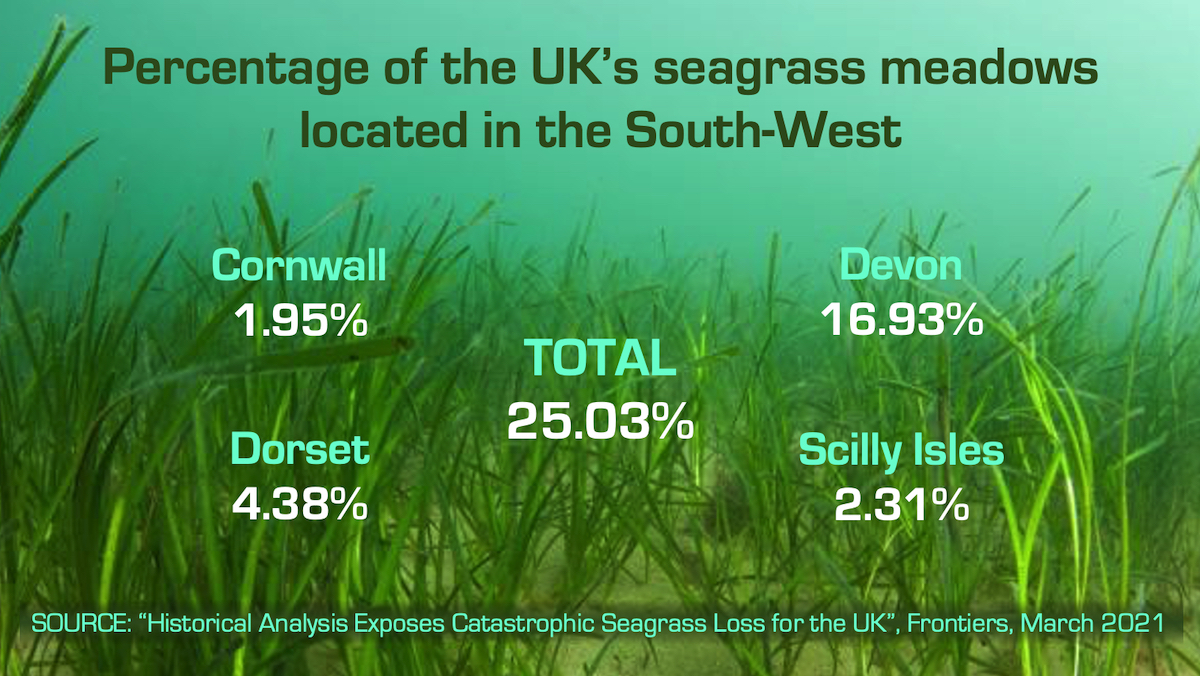
During lockdown, our seagrass meadows showed signs of an incipient recovery. To give an example, the largest number of spiny seahorses since 2008 were seen in Studland Bay (Dorset). Only two live specimens had been spotted since 2015, and a dead one in 2018, but already by halfway through 2020, sixteen sightings had been recorded. The Dorset Wildlife Trust and The Seahorse Trust attributed this to a reduction in human activity, boat traffic and damage from anchors which led to an increase in the amount of seagrass that grew that year, providing more food and somewhere for these shy creatures to hide.
Why does the increase in the number of seahorses matter?
It’s an indicator that sea habitats can recover and regenerate if we take appropriate action. Additionally, it vindicates the decision to designate Studland Bay as a Marine Conservation Zone (MCZ) in 2019. Monitoring the impact of anchoring in Studland Bay had shown a difference in the density of seagrass and bare patches outside the voluntary no-anchor zone (VNAZ). Since the establishment of the MCZ, the Marine Management Organisation (MMO), responsible for making bylaws in England’s inshore waters, has decided to introduce a VNAZ off of Studland Bay’s South Beach from December 2021, and to extend it after June 2022. (Contiguous beaches with significant seagrass meadows, Middle Beach to the north-west and Handfast Point to the east have not been afforded the same protection.)
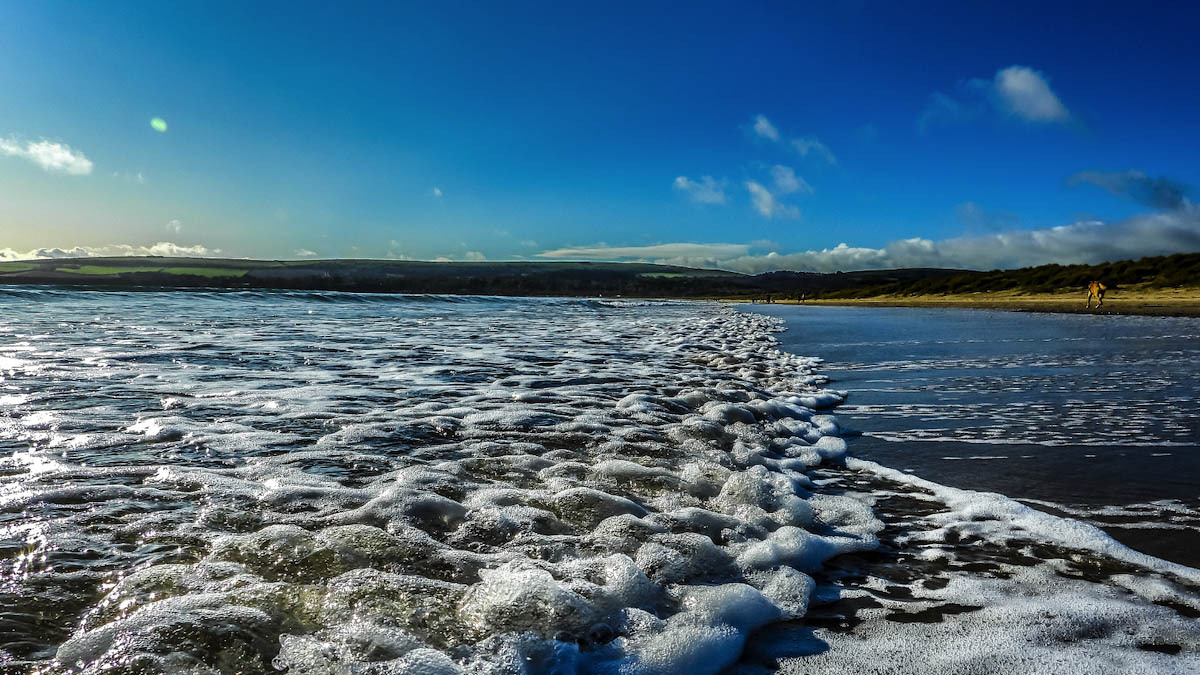
That’s where the good news ends…
A 2020 UN report estimated the rate of destruction of seagrass meadow to be seven per cent per year. Another recent study by UK academics and experts found that the “seagrass meadows of the British Isles are mostly in poor condition in comparison with global averages, with tissue nitrogen levels on average 75 per cent higher than global values.” Unsurprisingly, scientists say the rate of destruction in the UK is significantly worse than the global average.
A hectare is 0.01 of a square kilometre, so our 8,500 hectares means we only have 85km² of seagrass meadow dotted around the UK – that’s a little over half (52.7 per cent) of the area covered by the Bournemouth-Christchurch-Poole conurbation (161.3km²). A recent study by UK academics and experts found that since the First World War, 92 per cent of the UK’s seagrass has been destroyed, 50 per cent of it since 1936, and 39 per cent since the 1980s, due to anthropogenic activity.
Anchors and mooring chains are by no means the worst threat to seagrass meadows. The chief culprit is pollution. Mankind is destroying this incredibly important habitat – yes, partly through the use of sea bed-dragging anchors, but largely through the discharge of nitrogen-rich human sewage and livestock effluent. The practice of dumping raw and partially-treated sewage into our rivers and seas, and allowing nitrates from cattle farming to seep into our rivers, has been going on for some time, but is now reaching devastating proportions.
This is due to the perfect storm created by a shortage of HGV drivers to truck ferric sulphate to water treatment facilities (20 per cent of the UK’s 100,000 shortage of drivers being directly attributable to Brexit), and by increased rainfall – due to climate change – flooding drains where effluent and rainwater run-off are not separated. It poses a direct threat to our seagrass meadows as it results in increased levels of nitrates in our waters, which in turn leads to the growth of invasive algae that choke and kill seagrass.
It is estimated our 8,500 hectares of seagrass meadow can store 0.9 million metric tonnes (Mt) of carbon, worth £22m on the carbon market, but that prior to WW1 we had enough seagrass to store 11.5Mt of carbon, worth £281m. There has been some improvement since the 1980s due to the EU’s clean bathing water directive and other river/sea-friendly measures. However, the government has made no secret of the fact that it wishes to ditch this regulation, with government and Somerset MP Jacob Rees-Mogg claiming that low levels of regulation comparable to those of India (home of the Bhopal disaster) would be good enough for the UK. Untreated effluent, including human waste, wet wipes and used condoms, was dumped into England’s rivers more than 403,000 times for in excess of 3 million hours in 2020, up from 292,864 times for around 1.5 million hours in 2019.
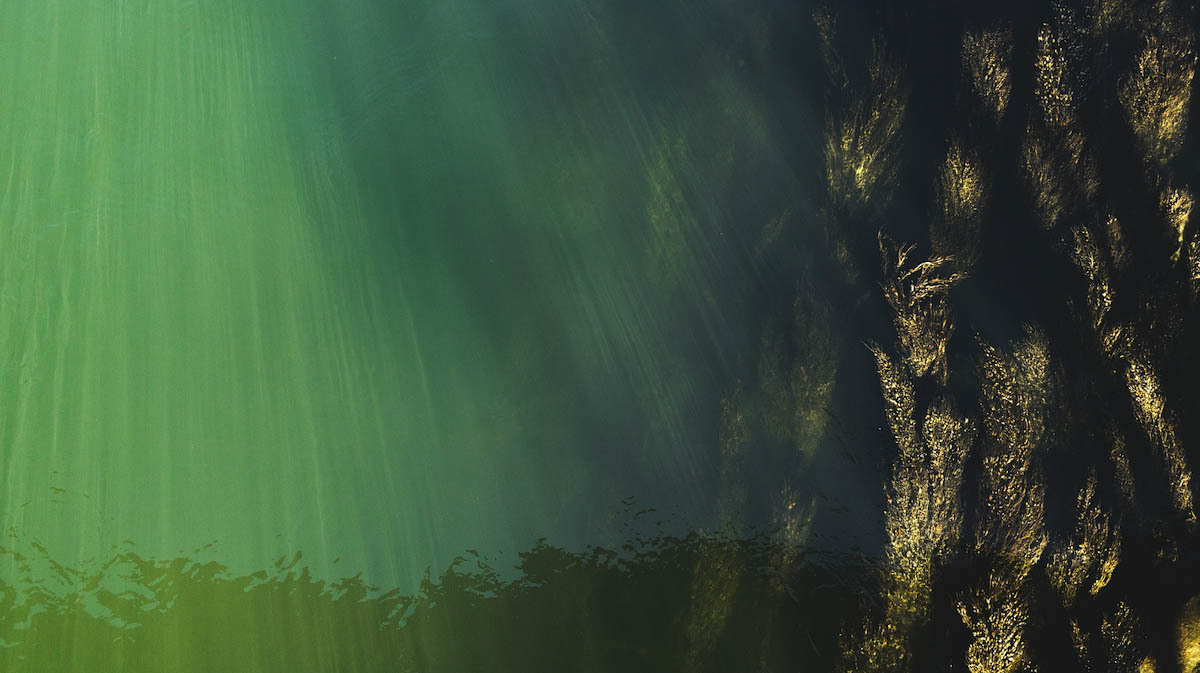
Has the UK government properly costed pollution?
It was disturbing that a majority of Tory MPs voted NOT to impose a duty of care on water companies, despite the increase in the discharge of raw and partially-treated sewage to unsustainable levels. Worse still, the environment minister and Taunton MP Rebecca Pow cited as an excuse an inflated cost of £150bn to £660bn to replace antiquated sewage systems, giving many Tory backbench MPs and pundits an apparent justification for their vote. It was a statistic which government-supporting media picked up on and amplified. Ms Pow has been asked to explain how she arrived at the astonishing estimate, which, to put it in context, ranges from 37.5 per cent to 165 per cent of the total amount (£400bn) borrowed by the government to fight the Covid-19 pandemic.
So far, she has declined to show the workings of her mathematics or to state what the cost of doing nothing would be, so that a fair comparison could be made. Nor indeed has she estimated the cost of needing to resort to costly building projects for sea-wall defences, the decline in fish stocks and the sabotage of our own net-zero efforts by killing off a natural form of carbon capture through raw sewage discharge.
That bogus estimate is ten times the £36.9bn to £62.7bn cost estimated by the government’s own Storm Overflows Taskforce, which consists of representatives from the Environment Agency, the water industry and Ofwat. Yet this random figure was used to justify a tsunami of acidic and patronising put-downs of voters by some Tory MPs, who told us we didn’t understand the nuances of the Environment Bill, we were politically rather than environmentally motivated, and are merely a bunch of lefty activists in thrall to Andrew Adonis (who is feuding over the issue with unelected environment minister Zac Goldsmith in the Lords).
Before our government struts about on the world stage at COP26 and we lecture the Brazilians about their mismanagement of the rainforest, should we not first address our own mismanagement of our rivers and seas? Not a single river in England is unpolluted. That is tragic and unacceptable. It is also an issue that cuts across political affiliation and the Brexit divide, so our MPs had better get their act together and recognise the strength of public feeling, rather than dismissing it as merely a lefty plot to make them look bad.
Sadly, there is no single silver bullet to solve the climate crisis. Sorry. There just isn’t. This is a serious topic where false optimism risks creating a smokescreen that distracts us from doing what we need to do. However, carbon capture is one of the five levers the Climate Change Committee has identified to combat the problem, and seagrass meadows could play a vital part in that.
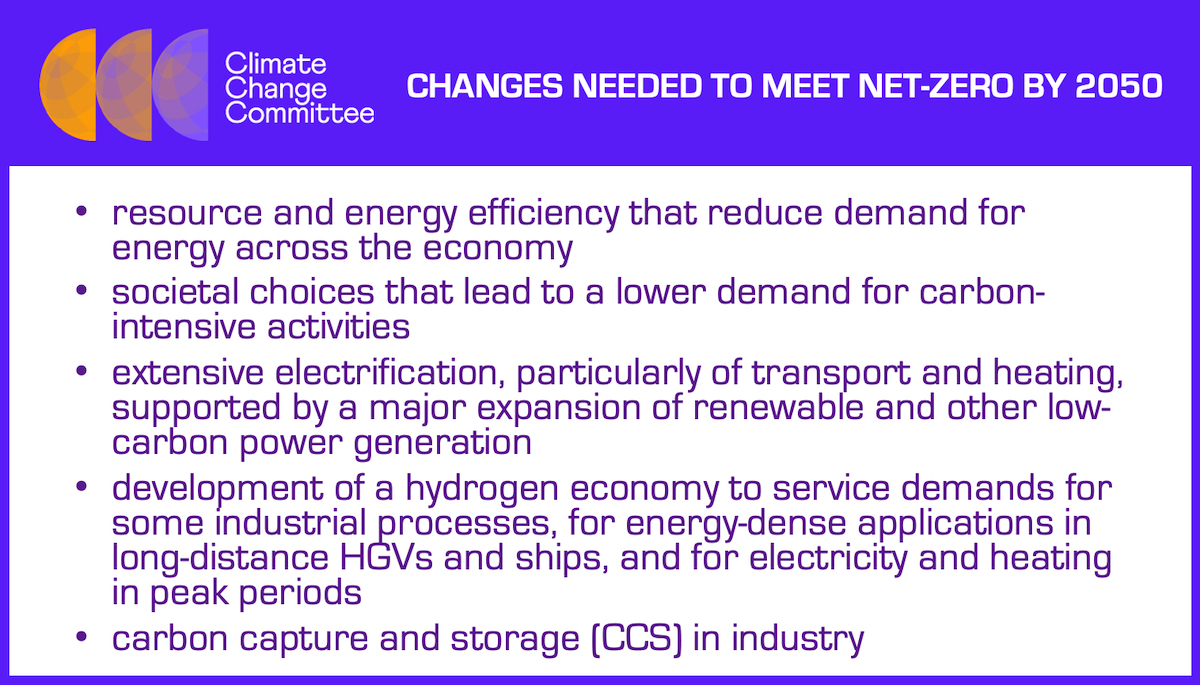
We must step up our opposition to this incompetent government and demand that something real and meaningful is done, rather than a cosmetic sop that allows MPs to kick the issue into the proverbial long grass. Convincing our local MPs in the South-West to focus on seagrass protection and regeneration for the sake of conservation, carbon capture and human survival might help to achieve that. As Alix Green of University College London said, “The UK is lucky to have such a resource in our waters, and we should fight to protect it.”





